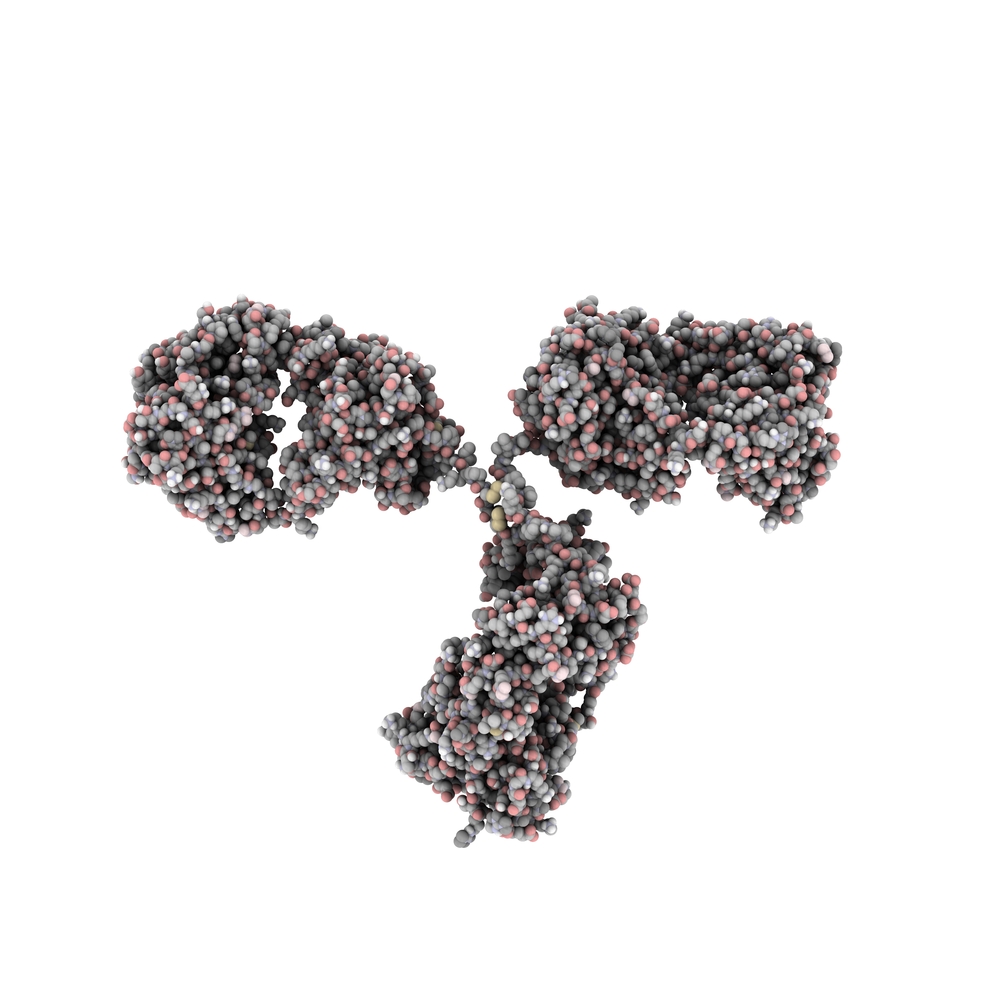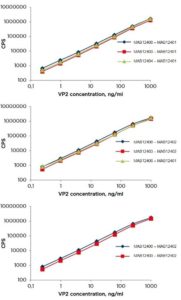ELISA: Calibration curves for CPV sandwich immunoassays (capture MAB – detection MAB). Capture antibodies were absorbed to microtiter plate wells. Detection antibodies were labeled with a stable europium chelate (200 ng/well). Recombinant CPV‑2 VP2 capsid protein (REC31788) was used as an antigen at a concentration 50 ng/ml. Capture MAB was used at 1 μg/well. Sample volume was 100 μl.
Mouse Anti-Canine Parvovirus 2 Antibody (8H7)
$428.34 – $1,074.82 excl. VAT
Mouse anti Canine Parvovirus 2 antibody (8H7) is a monoclonal antibody that is specific for CPV-2 capsid protein VP2. The antibody and binds Canine Parvovirus (CPV) in clinical samples and is suitable for use in ELISA, LFA, WB, Immunodiffusion, and Haemagglutinin Inhibition. MAB12401 can be used as a detection antibody with MAB12400, MAB12403 or MAB12404 as a capture antibody. See our Matched Pair Antibodies for more information.
MOUSE ANTI-CANINE PARVOVIRUS 2 ANTIBODY (8H7)
Mouse anti Canine Parvovirus 2 antibody (8H7) is a monoclonal antibody that is specific for CPV-2 capsid protein VP2 and binds Canine Parvovirus (CPV) in clinical samples. The antibody is suitable for use in ELISA, LFA, WB, Immunodiffusion, and Haemagglutinin Inhibition. MAB12401 can be used as a detection antibody with MAB12400, MAB12403 or MAB12404 as a capture antibody. See our Matched Pair Antibodies for more information.
PRODUCT DETAILS – MOUSE ANTI-CANINE PARVOVIRUS 2 ANTIBODY (8H7)
- Mouse Anti Canine Parvovirus 2 Antibody (8H7).
- Isotype Mouse IgG2a.
- Hybridoma clones derived from hybridization of Sp2/0 myeloma cells with spleen cells of Balb/c mice immunised with canine parvovirus.
- Purified by chromatography on protein A Sepharose.
- Suitable for use in ELISA and IFA, WB, Immunodiffusion, and Haemagglutinin Inhibition.
- Antibodies bind recombinant CPV‑2 capsid protein VP2 as well as CPV from clinical samples.
BACKGROUND
Canine parvovirus (CPV) belongs to the genus Protoparvovirus and the family Parvoviridae and causes a highly contagious and fatal disease in dogs (Kelly, 1978). The symptoms include lethargy, loss of appetite, fever, vomiting, and severe (often bloody) diarrhea. Parvoviral infection must be considered as a possible diagnosis in any young dog with vomiting and/or diarrhea. Puppies and dogs usually become infected when they ingest a virus that has been passed in the feces of an infected dog. Vomiting and diarrhea can cause rapid dehydration, and most deaths from parvovirus occur within 48 to 72 hours following onset of clinical signs.
CPV is a non-enveloped DNA virus with an ~5000nt, single-stranded DNA genome containing two open reading frames (ORFs). The first ORF encodes two non-structural proteins, NS1 and NS2. The second ORF encodes two structural proteins, VP1 and VP2. VP1 and VP2 each encode parts of the viral capsid, which is assembled from 54 copies of VP2 and 6 copies of VP1. VP2, the major capsid protein, is also the major antigenic protein and determines viral tissue tropism and host range.
The disease can be prevented by vaccination and CPV‑2 vaccine is recommended as a core vaccine that should be given to all dogs. However, there are concerns regarding the complete efficacy of existing vaccines against antigenic variants which may evolve to escape the immune system via antigenic drift, resulting in vaccine failure. (Zhou et al., 2017).
The Native Antigen Company provides several monoclonal antibodies specific to CPV‑2. Antibodies bind recombinant CPV‑2 capsid protein VP2 as well as CPV from clinical samples. All MAbs have been tested as capture and detection antibodies in sandwich immunoassays.
REFERENCES
- Kelly W. (1978). An enteric disease of dogs resembling feline panleucopaenia. Aust Vet J. 54(12):593.
- Zhou et al. (2017). The genetic evolution of canine parvovirus – A new perspective. PLoS ONE 12(3).


